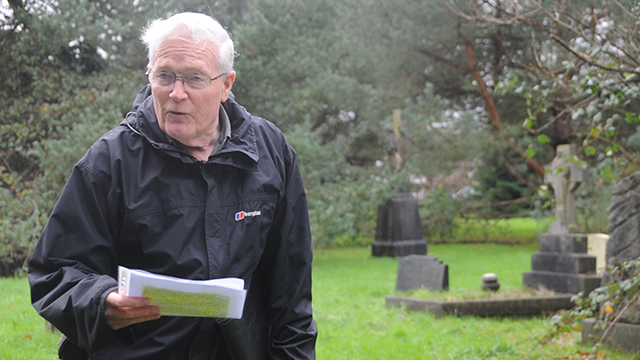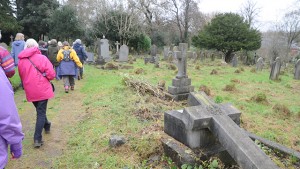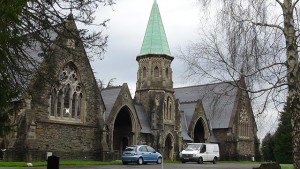“There is always new story to be discovered on grave”
Gordon Hindess talks about the Cathays Cemetery

That day a road of the Cathays Cemetery was muddy here and there. Gordon Hindess wearing gray-based outdoor clothes stepped into the grass with raindrops, looked back his followers and said.
“I really like this grave stone.”
As other people looked confused, he continued talking like a guide.
“Because you can tell a different story each coming. The first burial here was a professor of French in Cardiff University. …”
A handout in his hand had many yellow lined highlighting to be talked about.
Hindess is one of the leader of Tuesday’s weekly walk held in the Cathays Cemetery. Not only core members also new comer of Cardiff often join a walk.

This cemetery is the third largest in the UK and has a long history since 1859. Local residents’ organisation The Friends of Cathays Cemetery is working for maintaining the cemetery and promoting is importance since 2006. Hindes is also writing a members’ newsletter that is sometimes nearly 10 pages.
“There is always something new to find. I come here very regularly for years, then I find something never noticed before,” he says clearly.
“Headstone with hundred words to refer to the member of the families is absolutely fascinating”
He was not so interested in the Cemetery before. He liked walking and writing, but the place was just for recreation. “Cardiff produced the cemetery something interesting like geocaching. My family used that, just explored.”
But the retirement 15 years ago opened his eyes. “Suddenly I found there are more thing interesting. When your time was dictated, you like to concentrate day to day and there is less time to enjoy yourself,” he says.
He joined in the Friends in 2008 and reached the world of people under grave. “One headstone has a few hundred words to refer to the member of the families, it is absolutely fascinating.”
The Cemetery is an encyclopedia of Welsh history. Politicians, miners, ship-owners … All kind of people are here.
“There is always interesting story to find. What they did, how they did. Some people died to help other people,” he talks enthusiastically.
But Hindess says story of ordinary people grabs his interest more to feel the history and a connection to the world. “For example, one grave stone referred to an earth quake in Pakistan in 1930s, a British colony at that time, that was the worst devastated. They are not buried there, but it is a family grave so they often recorded the death of the family.”
It is hard to find stories of ordinary people because there is not so much information on the graves. But many people in Britain try to find their family story and sometimes contact the Friends for help. Then they can exchange information and found another story. “There are too many Williams or Jones in Wales, sometimes searching in the internet is waste of time,” he said humorously.
Cemetery as a sanctuary

Even though, most people may not find cemeteries as a place to visit for pleasure or refreshment like a park. Hindess has a slightly different opinion.
“Cemetery doesn’t support itself, so it is an economic side of the cemetery. It needs another purpose.”
He says it is protecting habitats. The Cemetery has a conservation area that encourages wildlife like flowers, animals, insects and fungus. “In 1970s, many big tombstones were moved to maintain easier and many impressive memorials disappeared. Fortunately it stopped, and also gigantic trees survived which carries wildlife habitats. Different character of the Cemetery.”
As memorials removed, there are many unmarked grave. Though hidden in the grass or memorials lost, 240,000 people are under the ground as residents.
“There is always something new to find. Not one interesting story, twenty, probably hundreds, and yet even more than that.”
“Hopefully, other people are keen to research because I am not good at looking for myself, but I will write.”
